Key Sub Systems
From a systems perspective, Ramboland is about transcending our tendency in this society to break things apart in an attempt to understand them, and in doing so, we miss out on the reality of how they work in concert. We have not been able to fully avoid categorizing our initiatives, considerations, lessons, and thinking into what we call Key Subsystems. In truth these sacred, Classical Elements have been expressed in some form in pretty much every known human culture in Earth’s history. They are real, valuable, and useful – especially when approached from a whole-system perspective. When we start and end from the whole, unpacking the elements / subsystems in between actually better highlights the interdependencies and overlaps among these systems, which can change design and management insights. This is a part of what we consider to be the important work of re-wholonizing as we design and manifest designs (Barbara Lima & Max Zahniser). Having said that, our Key Subsystems are currently organized as follows (many of our individual concepts – organized into the dots arrayed across the background images to call-out particular features – show up in several of the Key Subsystems, and/or in different ways):

Energy

Earth

Water

Air

Biological Life

Socio-economic & Cultural
From what we can tell, all the key subsystems exist to support the vitality, viability, and evolutionary capacity of Life as a whole. Many traditions do not limit the idea of Life to biology, but recognize an aliveness of all “inanimate” things, and world and universe at large. Biological Life is a clear expression of strong emergence, aka the whole being greater than the sum of its parts, and having thought through all the other elements, it is clear how inextricably intertwined, or not even at all separate enough to be woven. Even “weaving” suggests a prior separateness and new combination that is a human projection onto a unified Whole. The re-wholonizing is not so much in reality, as in our conception of it, except in as much as we have actually torn these things apart to reflect our misguided inclinations to divide.
Energy
Arguably both the most fundamental and the most expansive in its manifestations. Throughout various cultures the beliefs about the energy element span many arenas from being the building “blocks” of the universe, and even ideas themselves, to spirit, souls, Life itself, and beyond.
Many believe that there are subtle energies that are less tangible and detectable but still influence living beings and the universe. And we all know that there are forms of energy that we can’t perceive without technological help. It would be illogical to think we can perceive them all with our current technologies.
There are hypotheses or articulations that suggest that even matter is just energy vibrating at rates and frequencies that present as atoms, etc., though this is not universally accepted or understood, nor disproven, in the scientific community. It still functions as some folks’ Theory of Everything (or TOE).
In physics, energy is defined as the capacity to do work, or the ability to cause change or movement of any sort.
Energy is present through everything that happens in this world and even beyond in our universe. It is essential for all natural, mechanical, human, and non-human processes. So energy to us means more than just utilities, or generating and utilizing solar power. It means considering all the forms of energy entering and exiting the site system and beyond.
Click here to learn about how Energy tends to work in American cities
Click here to learn about how Energy COULD work in American cities
Explore the tool-tips (colorful little clickable dots with information in them) the digital twin environment to the right to learn how this could express itself at this scale.
Earth
Across various cultures and spiritual traditions Earth symbolizes stability, grounding, fertility, and the interconnectedness of Life. It is often associated with the feminine, representing the nurturing and sustaining qualities of the natural world. In many belief systems, the earth element is linked to the physical body, the material world, and the cyclical nature of existence.
Earth is materiality, soil, minerals, and other tangible resources. Earth makes Life possible by providing a habitable environment for all forms of Life, including the myriad of micro-nutrients that were initially trapped deep within her body.
In integrative design it's important to consider the properties and qualities of materials we use, as well as the means of extraction, manufacturing, transportation, installation, “useful” (to humans) life, and likely end of “useful” life (disintegration, decomposition, uptake, or not, etc.).
Click here to learn about how Food works in most American cities
Click here to learn about how Food COULD work in most American cities
Explore the tool-tips (colorful little clickable dots with information in them)accessible when you click in the digital twin environment to the right to learn how this could express itself at this scale.
Water
Lifeblood of the Earth. Water is revered across cultures and spiritual traditions for its Life-sustaining and transformative qualities. It symbolizes purity, renewal, and the flow of life, and is often associated with emotions, intuition, and the subconscious mind. Water is also linked to healing, cleansing, and fertility, and plays a significant role in rituals and ceremonies aimed at purification and spiritual connection.
Water is a medium, and more. Mediums have value most, or perhaps only, when in motion; we can orchestrate this movement, but obstruct it only for short periods of time, otherwise to our peril.
It is important to consider how we capture, treat, conserve, use, and release water. Doing that in a way that resembles the natural water cycle is a design goal for the Ramboland site. In healthy temperate forest ecosystems water moves mostly vertically – rain replenishing groundwater storage and the aquifer, and water being released back into the air through evapotranspiration. This design by nature allows water to fulfill its purpose, to support Life, control climate, be purified and purify other systems, etc. However, humans have been treating rain as a nuisance in the design of our civic water systems for a long time now – and the water we treat as a nuisance becomes such. Ramboland aims to demonstrate ways to integrate, conserve, and even treat this precious resource in an urban environment.
Click here to learn about how Water works in most American cities
Click here to learn about how Water COULD work in most American cities
Explore the tool-tips (colorful little clickable dots with information in them)accessible when you click in the digital twin environment to the right to learn how this could express itself at this scale.
Air
“All things share the same breath - the beast, the tree, the man…the air shares its spirit with all the life it supports.” — Chief Seattle.
The element of air holds significant sacred meaning across various cultures and belief systems, often representing breath, communication, freedom, and the spirit. It is associated with life force, intellect, and the unseen yet powerful forces of nature.
Air is critically important that we take more care in considering how we treat our air and what we put into it, inside and outside of buildings. Buildings account for approximately 39% of global energy-related carbon emissions (EIA, DOE), and often have 10x to 100x as much airborne particulate and contaminants in their interiors compared to average outdoor conditions (Greenguard).
Ramboland would sequester far more carbon than it emits, and all the plants on the site would generate far more oxygen than the human inhabitants consume. Careful thought has gone into all the material choices in the building to make sure that no adhesive, paints, or treatments will be used that emit harmful pollutants into the interior and into the atmosphere. Air filtration and circulation systems keep air flowing through the house and the greenhouse.
Click here to learn about how Air works in most American cities
Click here to learn about how Air COULD work in most American cities
Explore the tool-tips (colorful little clickable dots with information in them)accessible when you click in the digital twin environment to the right to learn how this could express itself at this scale.
Biological Life
The end for all the means to lead to. From what we can tell, all the other elements / key subsystems exist to support the vitality, viability, and evolutionary capacity of this one. Many traditions do not limit the idea to biology, but recognize an aliveness of all “inanimate” things, and world and universe writ large. That view might be better seated at our “All” key subsystems / elements level. Biological Life is a clear expression of strong emergence, aka the whole being greater than the sum of its parts, and having thought through all the other elements, it is clear how inextricably intertwined, or not even at all separate enough to be woven. Even “weaving” suggests a prior separateness and new combination that is a human projection onto a unified Whole. The re-wholonizing is not so much in reality, as in our conception of it, except in as much as we have actually torn these things apart to reflect our misguided inclinations to divide.
Transcending and including them all, in a process of weaving complexity and mutualism out of decay and decline. The vitality of humanity requires our living systems, and to heal and increase the vitality of the other living systems, we are needed. This must not be reserved for less “developed” suburban, rural, and wilderness areas. Our cities can and must serve as rich ecological zones, and this is more possible than we might think. Like sunken ships providing surface area for the restoration and/or growth of coral reefs, our built-environment can be designed and retrofitted to support many forms of interdependent life, as well as enable better self-nourishment with the various elements. In concert, Life becomes far more viable, and with humans playing their role in these systems we are richly rewarded with provisions for our emotional and physical needs. From such a point of wealth and health, we can co-evolve to unimagined levels of capacity.
Click here to learn about how Biological Life works in most American cities
Click here to learn about how Biological Life COULD work in most American cities
Explore the tool-tips (colorful little clickable dots with information in them)accessible when you click in the digital twin environment to the right to learn how this could express itself at this scale.
Socio-economic & Cultural
The idea of Collective consciousness suggests that there is a shared, underlying consciousness or awareness that connects individuals within a group, society, or even humanity as a whole. This concept has roots in various philosophical and spiritual traditions, as well as sociological theories. It implies that there are shared beliefs, values, and even archetypes that influence individual thoughts and behaviors.
The somewhat more tangible structures and processes of human interaction that realizes our shared fates are critical to bridging our more subtle connections with the physical infrastructure sharing this project proposes and demonstrates.
In modern society, communities are often separated – we have enough people nearby but we don’t behave like a village functionally nor socially. All of these other Key Systems conspire to facilitate humanity thriving. But thriving also requires us to come together to meet the social needs amongst our community. Ramboland is not only a vibrant example of what's possible with green building, community agriculture, renewable energy, and progressive water management, it will be a living laboratory where people will come to grow food, learn about regenerative principles and systems, and learn about resilience, access, and inter-dependence. All of this is the result of our community engagement efforts and will, in turn, catalyze further engagement within the communities we serve. What happens at Ramboland can reverberate widely out into the world and will hopefully inform a wave of regenerative repatterning of society. But ALL of that is predicated upon also tending social, cultural, and economic structures and processes that can support establishment of these systems and their sustainable, mycelial spread. We can prove what's possible here and use this as a model for all kinds of housing and other urban solutions that are so greatly needed by so many people around the world, but if the “software” of these financial and community connectivity considerations behind all this hardware are not also taken seriously, it will not work.
Click here to learn about how Education works in most American cities
Click here to learn about how Neighborhood Economics work in most American cities
Click here to learn about how Education COULD work in most American cities
Click here to learn about how Neighborhood Economics COULD work in most American cities
Explore the tool-tips (colorful little clickable dots with information in them)accessible when you click in the digital twin environment to the right to learn how this could express itself at this scale.

Horizontal Navigation
Scroll left and right or use the navigation above to explore different scales of the project.

Vertical Navigation
Scroll vertically or use the buttons on the left to explore Ramboland through different Key System perspectives.
the Digital Twin?
Welcome to Ramboland's digital twin! Our unique navigation system allows you to explore this groundbreaking project from multiple perspectives.
Dive in and discover how Ramboland is demonstrating that our cities can heal ecosystems while supporting all citizens. Your exploration of this digital twin contributes to the evolving vision of Ramboland. Enjoy your journey!
suggestion etc...
Your submission has been received!

Start Anywhere
Feel free to begin your journey at any point. There's no wrong way to explore Ramboland.







Keep Exploring
As you navigate, you'll uncover more about how Ramboland is reimagining our built environment for a sustainable future.
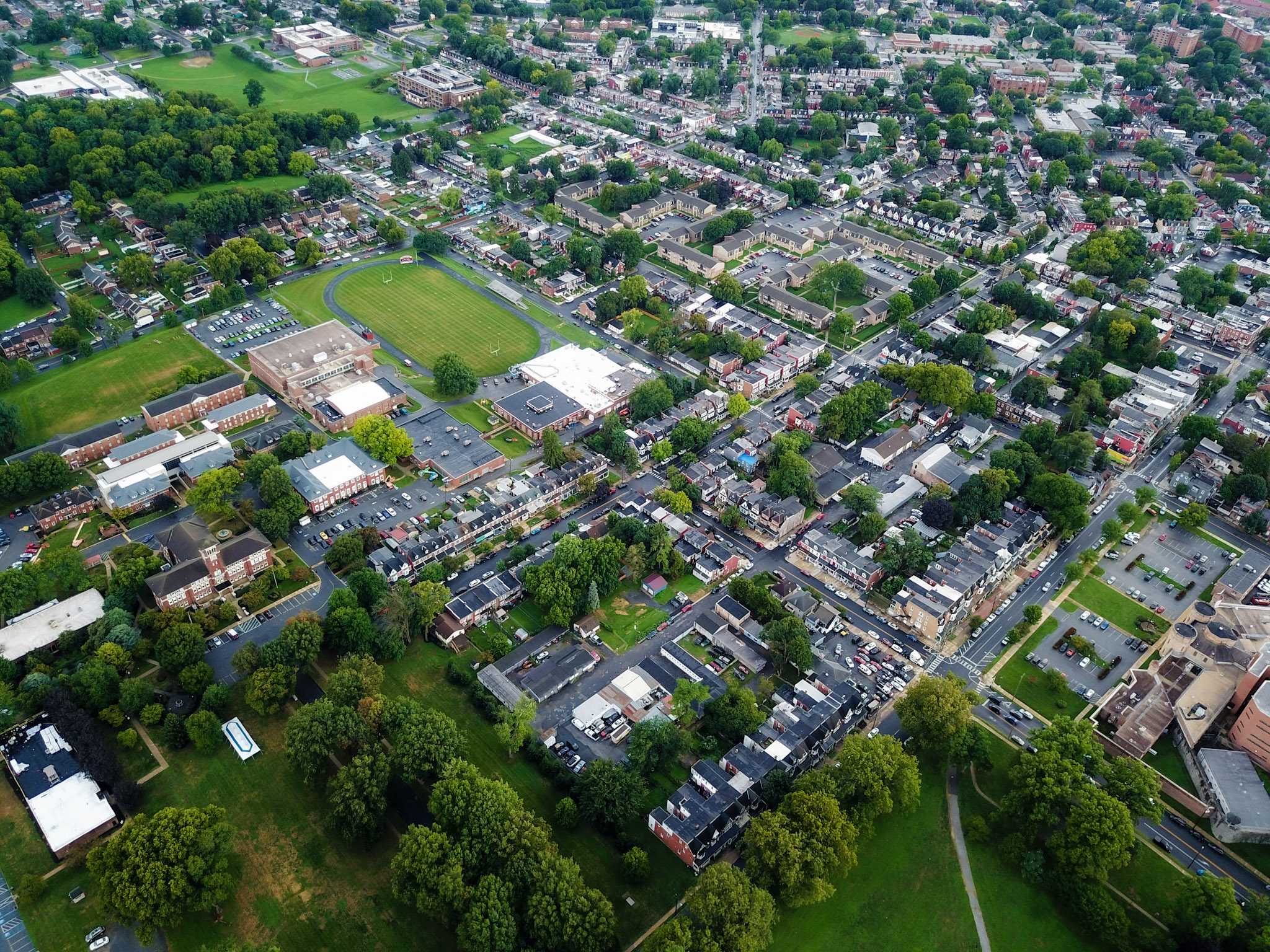


Explore the Community
Here you’ll find a view of the area with Ramboland in the middle. Buildings should be prosthetics for our surrounding living systems, and in a city thats a neighborhood. Click around amongst the key subsystems at this scale to learn about social and environmental issues and how Ramboland is connected to and addressing them.

Explore the Site
Here you’ll find a view of the Ramboland site itself. Click around amongst the key subsystems at this scale to learn about the specific features, strategies, and technologies employed throughout buildings and outdoor spaces, across the same set of key subsystems.

Explore the Features
Here you’ll find information about features that are at a scale too small or maybe too large for the other two scales (like details inside the buildings), as well as some other information that isn’t specific to a locational spot or area.

Solar Arrays on Garage and House
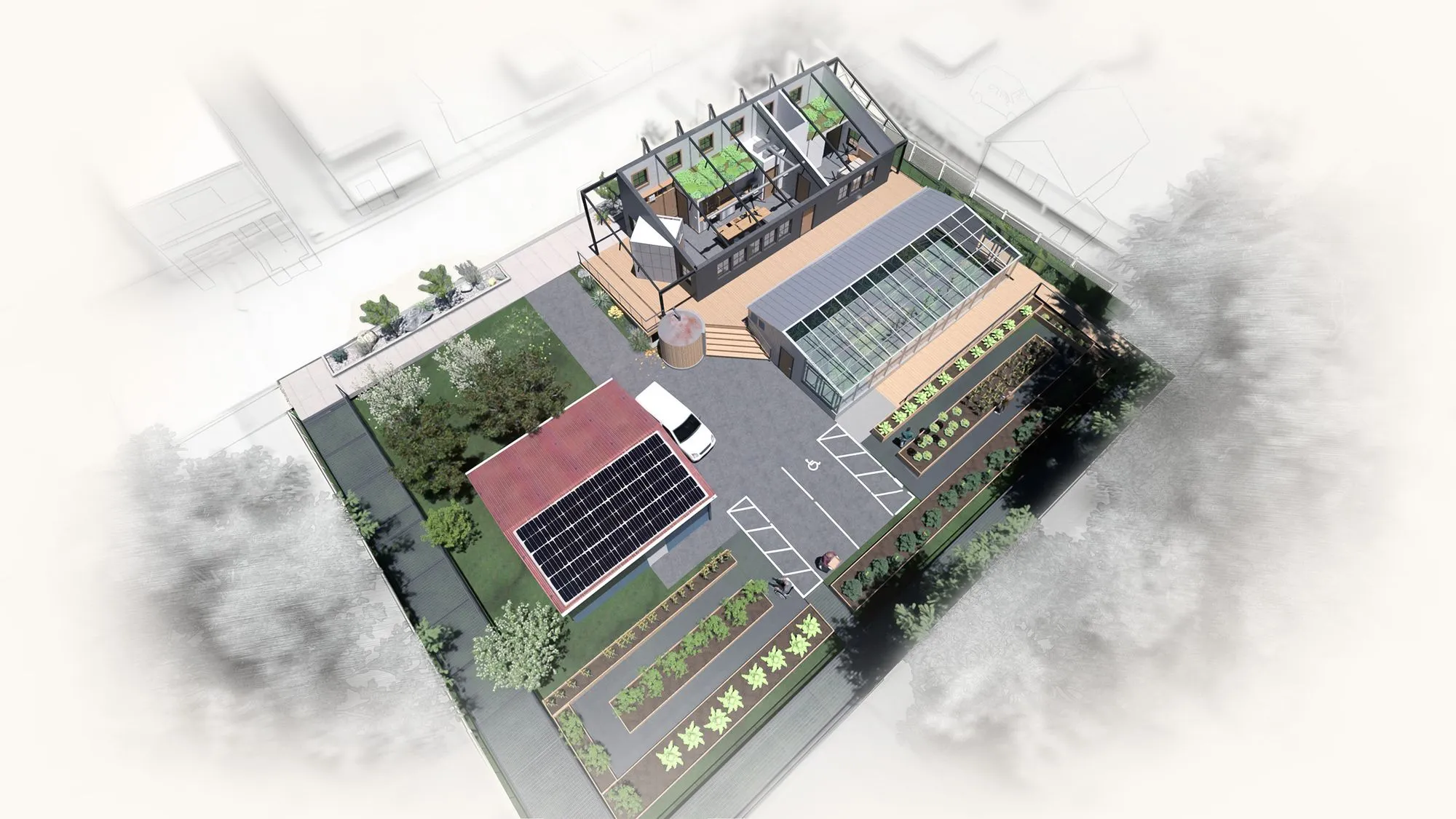

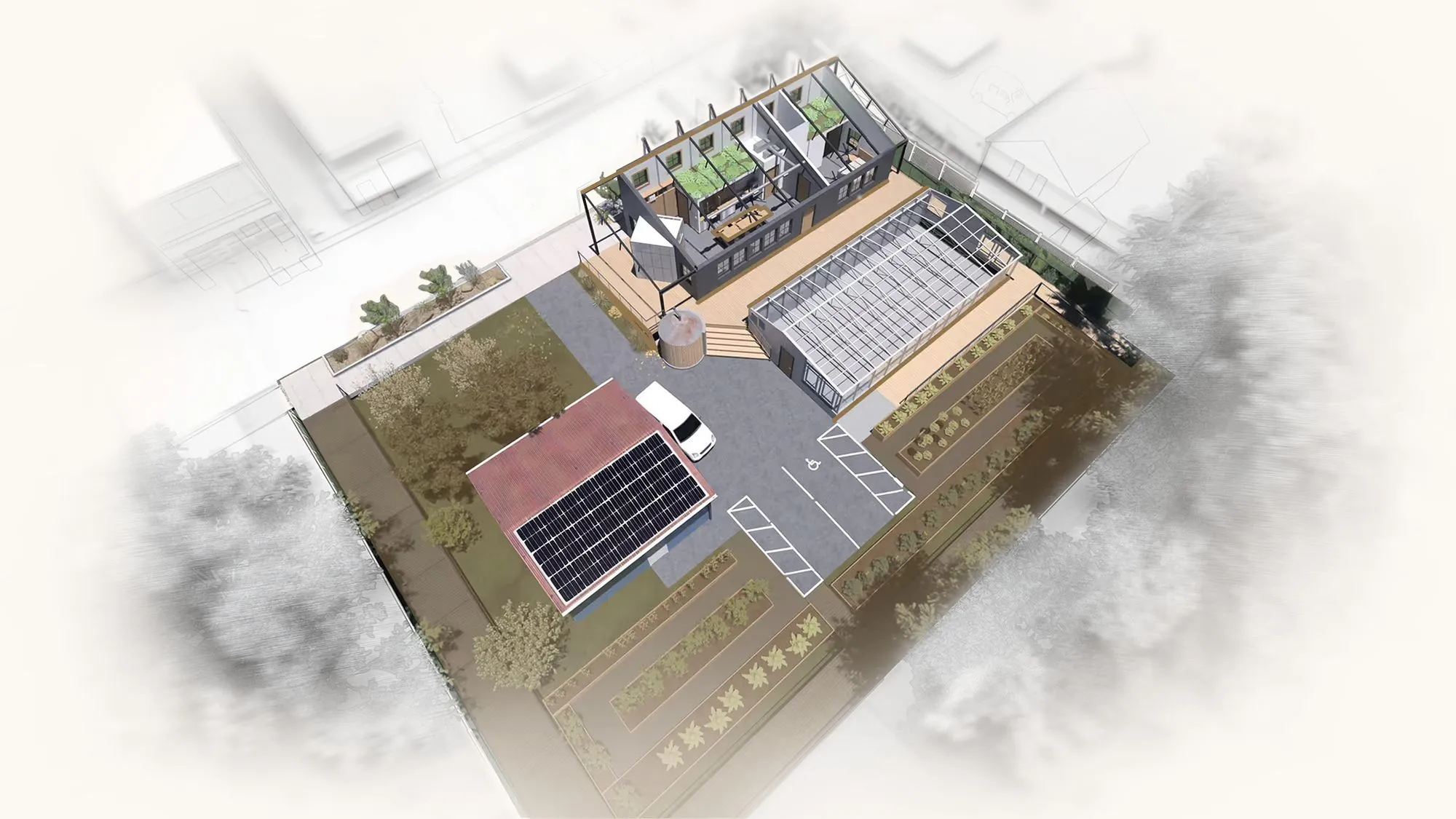
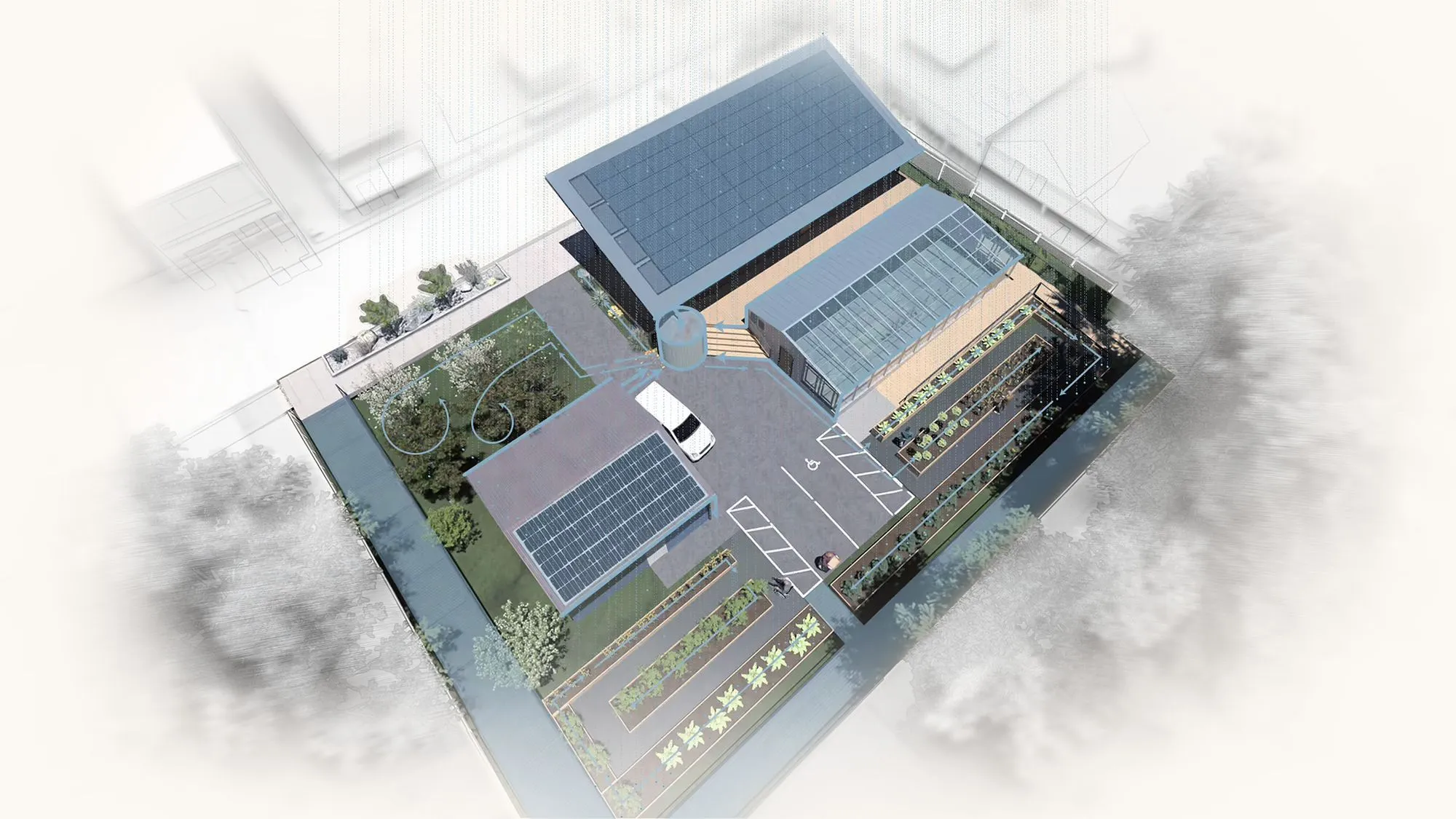
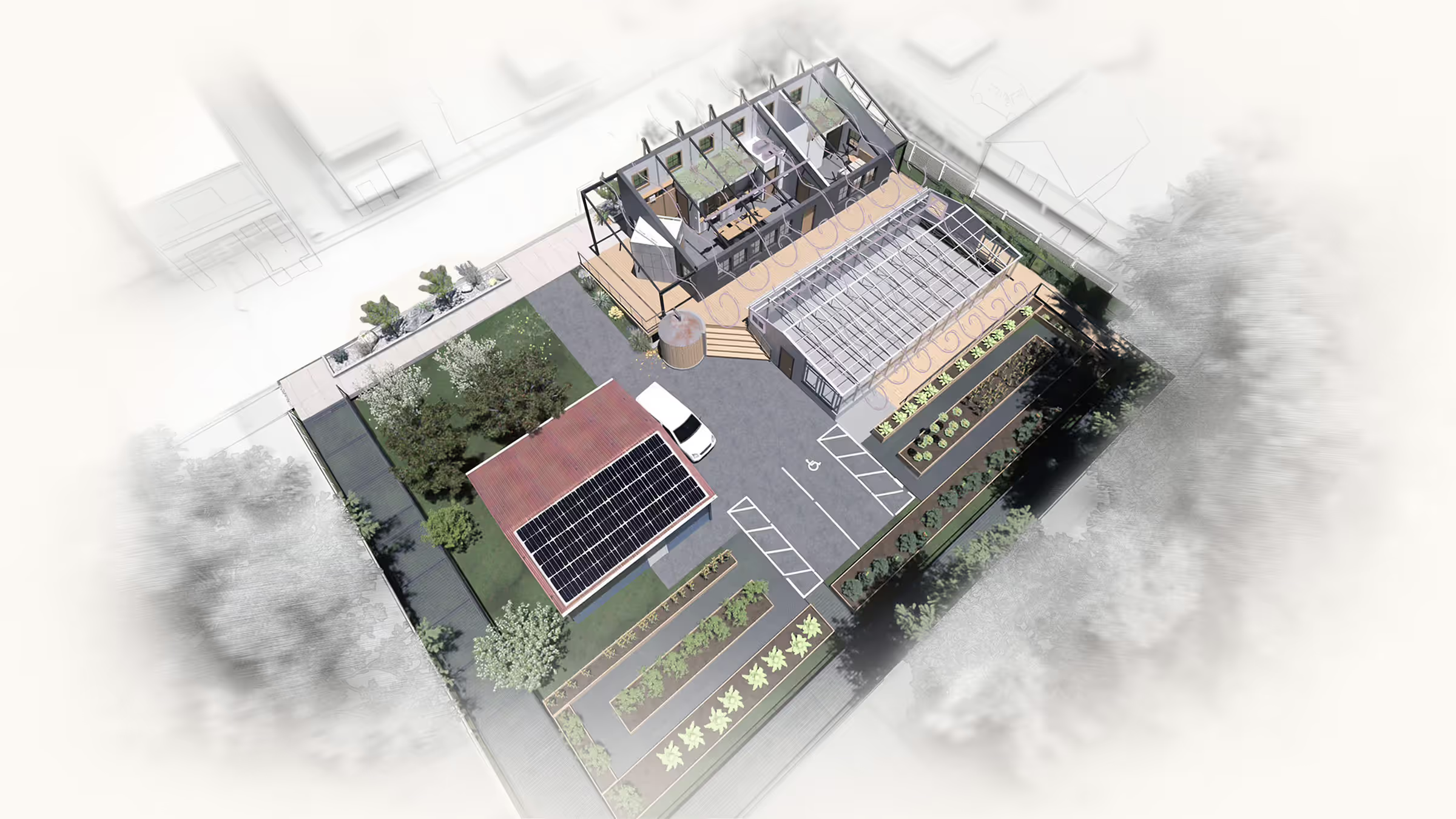
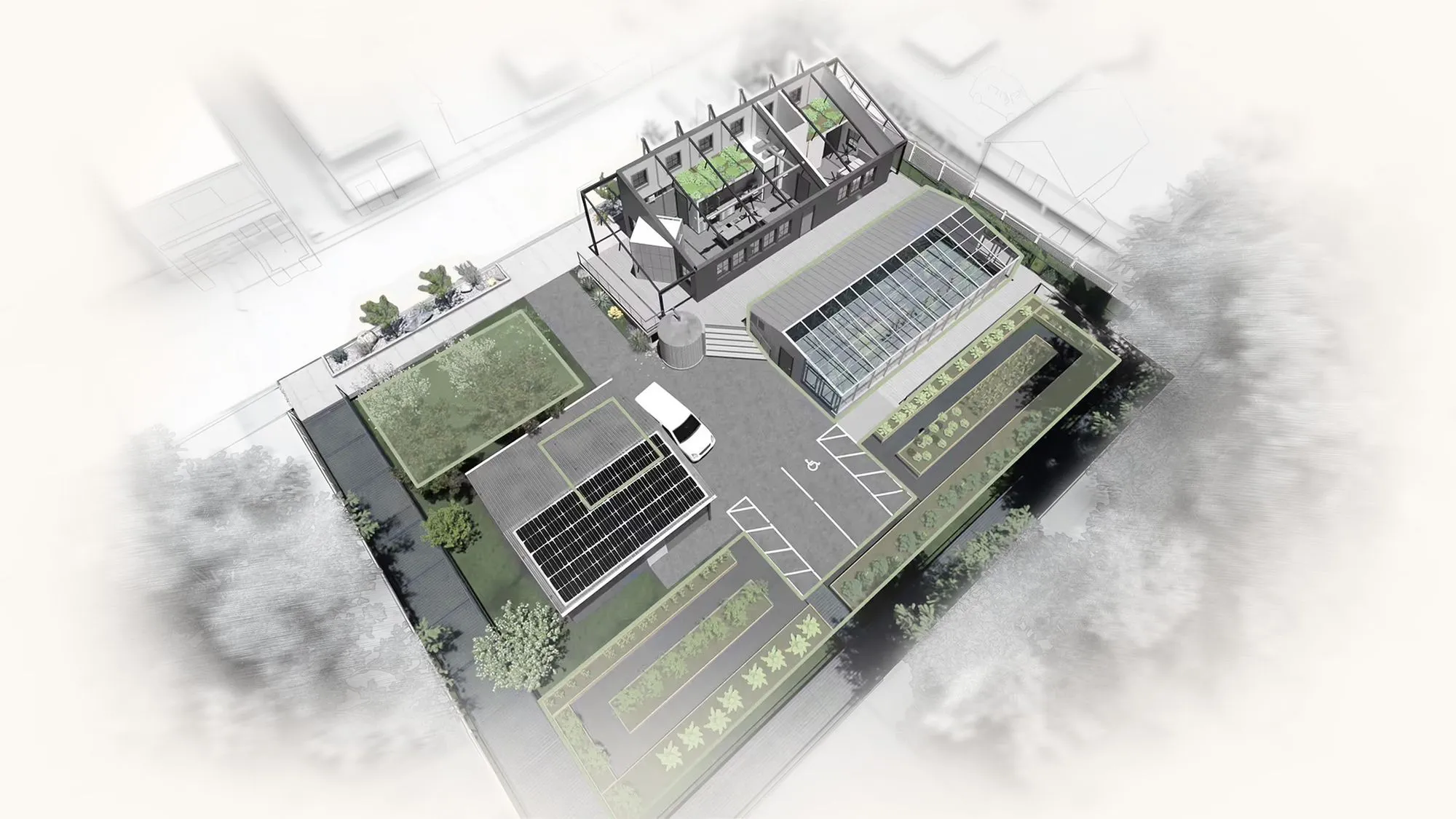













.jpeg)
Research and projects indicate that energy microgrids can achieve "islandable" status while producing a far smaller surplus of energy if they have massive and dynamic storage in the form of electric vehicles (EV) that are consistently connected to them via two-way chargers. We have wanted to provide a wheelchair modified EV as part of this project all along. Now it may have even more purpose.
This insight from one of our energy engineers triggered a set of unexpected additional ideas with one of our civil engineers and our food system and building architects. What if our YIMBY program, which expanded Ramboland’s system approaches to neighbors' yards, could connect across streets using the EV – transporting food, energy, and water? What if, instead of direct piping from neighbors' roofs to our cisterns, we placed rain barrels at YIMBY houses on other blocks, in this and other low-income neighborhoods, and would be able to transport them by EV if needed? It could be calculated based on rainfall and roof collection areas when those barrels would be full. The EV couldbring an empty barrel, and swap it for the full one, as well as take that water to one of our partner's sites, such as DECA City Farms, to fulfill additional water needs or provide chlorine free rainwater for food production. Having dropped off several full rain barrels the EV van with a liftgate would be empty and able to haul crops from the other farm to either locations where canning, jarring, pickling, etc could occur, or directly to a sales point or a free distribution point like a food bank, church, park, or community center.
This torque-intensive, low-milage journey is a perfect fit for the strengths of EV's, and it would likely return to its charger at Ramboland with a lot of remaining battery charge. If the nanogrid decided it made sense for economic or energy resilience reasons, that excess charge could power the house, recharge its batteries, or charge batteries in neighboring houses to prevent refrigerated food loss or medical device power loss during a blackout.
Likewise, the EV's could actually deliver charged batteries from energy surplus producing sites, to energy deficit suffering YIMBY partners as well.












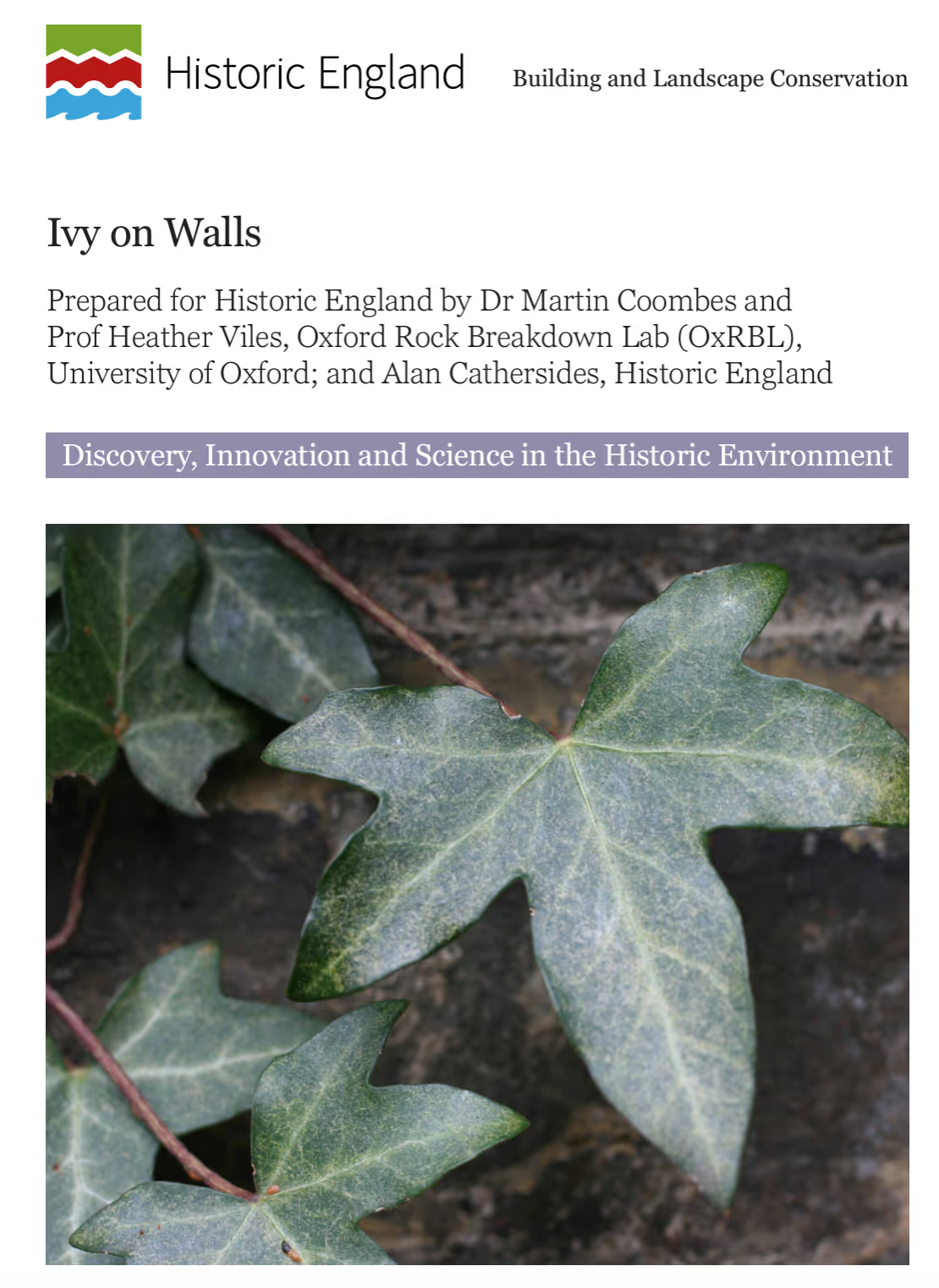
Architecturally structured pockets of air organized against north wall increasing insulation (effectively) on the side exposed to cold winter prevailing winds. In other words, closets, murphy beds, mechanical rooms, cabinets, bathroom, and even the vegetation on the exterior, all further protect and insulate the most thermally vulnerable exposure of the building. An Oxford study found that heavily vegetated building facades were not only an average of 15 degrees cooler in the Summer, but more surprisingly 10 degrees warmer in the winter!












.jpeg)
In most cities, including Lancaster, shared alleys can be improved and utilized in a number of ways as long as all the neighbors are in consensus about it. Utilizing some of this space to provide better wheelchair and pedestrian access through the core of the block and to the resources at Ramboland, for the neighbors, several of whom rely on access to their backdoors because the steps on the front of their houses are not manageable. Furthermore, a boardwalk can serve as a spine for conduit, hose, and pipe for the connectivity of neighbors enrolling in the YIMBY program to link up their homes to the Ramboland utility network.












.avif)
After we planned the building, we placed the mechanical room, closets, and a few other enclosed spaces along the northern wall of the home (*). We also designed the cross-ventilation so that as air warms, it rises and is pushed and pulled out through upper windows (**) above the mechanical room, using the prevailing winds. This left us with a design challenge: how to cap the mechanical room in a way that worked with the airflow and overall plan.
Leaving it open would expose the main living space to all the noise of the equipment in the mechanical room, and also eliminate the opportunity for that room to function as a space in which air is pre-cooled in the Summer or pre-heated in the Winter by the equipment***, before being recycled into the space by a combination of the fresh air supply system and the high efficiency heat-pump above the bathroom****.
Indoor green roof moderates temperature and humidity, improves IEQ, IAQ in terms of ?, O2/CO2
*link to Passive Design 3 Tool-Tip
**link to Cross Ventilation Vignette
***link to HVAC pre-conditioning (not yet written)
****link to explanation of mechanical equipment












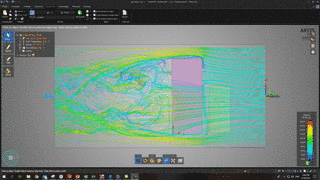
Since air conditioning (cooling) caught on in the U.S., designers of our buildings have largely ignored the effects of sunlight and wind on them, and as an industry and culture we've mostly lost touch with ways of not only reducing unwanted heat gains in Summer and losses in Winter, but conversely also don't typically consider or know how to maximize the beneficial inverse of these factors.
Surrounding massing of buildings, trees, topography, and
other structures are of course also key considerations. If there is or even may eventually be a large mass that blocks the sunlight to the south of the building, the southern windows won't be able to catch direct sunlight to gain more heat in cold months.
Surrounding elements can also be used to great advantage also. For example trees that drop their leaves in cold months will let sunlight through to reach the buildings and heat them, while they're fully leafed out canopies create shade and cooler microclimates underneath them in the warmer months. This makes them a great contributor to energy efficiency when they are located to the south, east, and west of the building. Coniferous trees which maintain their vegetation year round are very helpful in blocking cold winds from the NW direction in the Winter, and hot sun to the east and west, and even the north near the Summer Solstice.












.jpeg)
Most people are skeptical about including support for bats in their local ecology. But then they learn what bats eat – insects. Particularly since the Zika virus, Malaria mostly in other countries, and other mosquito borne pathogens made their debut,
Google AI Overview
Bat boxes can be good for a variety of reasons, including:
Protecting your yard: Bats eat many types of insects, including mosquitoes, moths, and beetles, which can help keep your yard pest-free.
Providing a safe place for bats: Bat houses offer a safe place for bats to roost, especially when they're raising their young.
Helping bats survive: Bat populations are declining due to habitat loss, and bat houses can help provide a place for bats to roost that they might not otherwise find.
Helping the environment: Bats are important pollinators and seed dispersers, which can help plants grow in new areas.
Being fun to watch: Bats are fascinating to watch, especially during their nightly acrobatics.












.avif)
As with the more public living/dining/kitchen/guest room, we wanted the bedroom first to be optimal in terms of accessibility and health effects, then second efficient in terms of space. Like the more public side of the wall, this room must not only be a medically well-equipped but homey bedroom, it also must be an entertainment space, dressing area, and an exercise room. While we did some tricky things with convertible furniture in the more public room, in this room we simply hung the entertainment system (TV, and HDMI streaming product, and a small soundbar with a great wireless headphone connection) from the roof/ceiling with some basic, inexpensive, but safe and strong hardware. We will likely add a single-size murphy bed as well, in case the queen sized one in the office nook is not sufficient for all the guests on a given night, or in the event that the caregiver needs to be in the same room for some overnights.













Ramboland features a pollinator hotel under the porch facing driveway. Pollinator hotels provide bees and other important pollinators with a safe site for nesting and overwintering, which offers benefits to humans and pollinators, as they are essential contributors to biodiversity and a healthy ecosystem. In urban environments, where natural habitats for pollinators are limited, integrating pollinator hotels in a green space or urban farm can increase biodiversity, lead to a more sustainable urban ecosystem, and enable agriculture that doesn't require herbicides and pesticides. Pollinator hotels are also great educational tools, raising awareness about the importance of pollinators and habitat conservation.












.jpeg)
Extended ramp and pier enable both accessibility and a diverse range of accessible viewing positions for those reliant on wheelchairs.












.jpeg)
Many crops can be simply upgraded with some labor. Canning, pickling, etc. can extend the shelf life of food, and increase the price it can fetch if sold. Food processing can happen on-site in the garage, minimizing transportation of crops. (Link to Vignette)












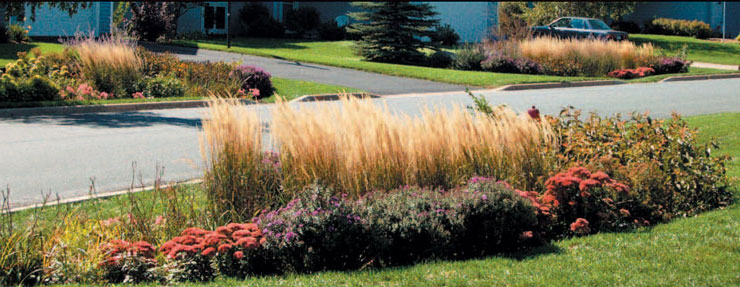
Including a bioswale where many developments would include a strip of turf grass in between the sidewalk and the curb and street has numerous benefits. In this urban agriculture project it can serve as additional area for food producing trees and possibly other plants, although the water treatment the plants in the swale will be performing will make it important for us to select species that don’t allow contaminants to make their way into the harvested portions of the plants (fruits, etc.). In addition to cleaning the water on its way to a sewer or cistern, these systems also slow the flow of the water, making managing the rainfall easier. They also serve to create an even stronger barrier between motor vehicles and vulnerable users of the sidewalk that a simple curb does.












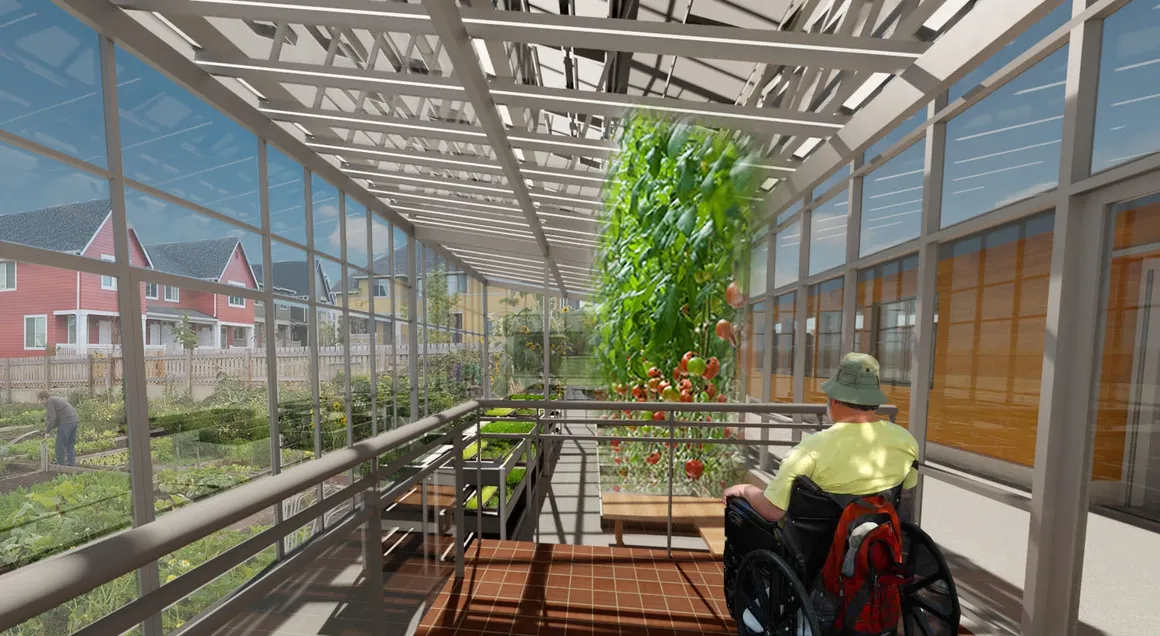
"Starts, growth, upgrade, teach, eat.”
The Ramboland “Fooding” System consists of the Greenhouse - used mainly for plant starts, the raised beds - used for plant growth, as well as the orchard, vertical screens, indoor green roofs, and outdoor green roofs – all on site. Ramboland’s on site “Fooding” System will produce much of the nutrition needed for the occupants and visitors of the house. Supplemented foods will only be needed for personal preferences and perhaps in the dead of winter, but we plan to tune portions of the greenhouse to address even the dead of winter. The agricultural products will also lead surpluses that can be sold and/or help feed food-insecure community members. The garage will be used for food processing like canning, jarring, pickling, etc., to increase the dollar value of the food and extend its shelf-life, also extending some of the food’s availability into cold winter months.
The site is just part of what we consider the “Fooding” System however, as partners like DECA, YIMBY (link to definition) urban farming efforts, and other future collaborations and farming opportunities will create what we plan to be a resilient system that can feed not only partners and YIMBY residents, but help bring healthy, affordable, and nutritious food to the entire community, eradicating food insecurity in Lancaster.













As water changes phase from liquid to gas, when it reaches the right combination of temperature and relative humidity in the air around it, it absorbs a bit of additional energy from adjacent molecules. This causes a cooling effect, which is why we sweat too cool ourselves, and many other living beings do similar things. It's also why a forest always feels a bit cooler than less vegetated areas nearby; their canopies are actually usually hotter than a "natural" area without trees, but thanks to the shade and this evaporative cooling effect, the area under the canopy is often cooler, so generally speaking: vegetation has a cooling effect on an area. Swamp coolers also take advantage of this, spraying a mist into a space. They are among the simplest of active cooling systems, simply using a pump and a fan, and some water. Luckily most times of year we'll have more water than we need thanks to our large rainwater treatment and storage systems, and the projected increase in total annual water arriving in fewer, bigger rain events.













A forthcoming level 2 (definition link) , possibly even level 3 (definition link), and definitely two-way charger (definition link) will not only support the optimization of the performance the Ramboland site (house plus Glassmeyer Farm; see TT about EV batteries) and the Ramboland Electric Delivery Vehicle, but also support other neighbors and their charging needs with clean renewable energy at lower cost than most stations - generating additional revenue for Ramboland and the co-owners amongst neighbors of those systems. In other words, it will be an additional way to produce revenue from a growing renewable energy system via YIMBY (link), justifying nearly limitless growth and renewable energy overproduction.













The kitchen will be a demonstration both of the best accessibility products and creative ways of arranging them to maximize their usability for as many users as possible; products like pull-down upper cabinets, height adjustable counters, sink, and appliances, and a wheelchair pull-in space between all of them, as well as space to add an upper refrigeration unit should Ron or other visitors or residents wish it to be available to those that can reach those higher levels. The induction cooktop will be embedded in the height adjustable island, with prep space between the two pairs of burners to improve usability by those preparing foods from a wheelchair, minimizing the need to maneuver the chair repeatedly while moving food and cookware onto and off of the safe induction heat surfaces.
Links to:












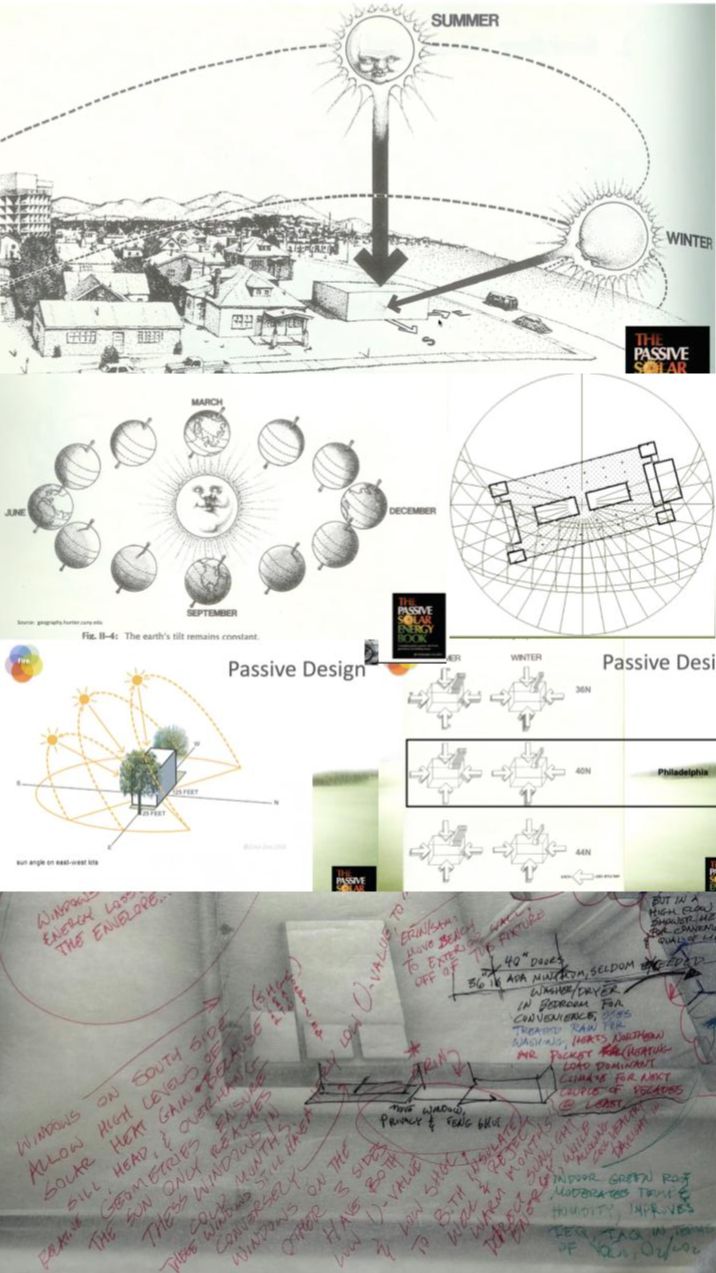
Windows on the south side allow high levels of solar heat gain because window sills, headers, and roof overhang relative geometries ensure the sun only reaches these windows in cold months, when we want the heat gain. In those months the sun angles are lower, and can get under the roof overhang to pass into the house and assist with heating it, reducing the burden on the mechanical heating systems. These windows still have a very low U-value to insulate well, however. Conversely, windows on the other 3 sides have both low U-values (insulate well) and low SCGC (Solar Heat Gain Coefficient), so they reject solar heat gain in the warmer months when we can't prevent the sun from reaching them. However the house has also been shaped and oriented such that we have far more southern exposure than east or west, because again, the southern exposure doesn't receive heat in the warm months, and does in the cold months. Conversely the minimized east and west wall sizes do the opposite of what you want them to; they gain heat in the Summer and don't in the winter, because the Sun rises farther northeast of the house and has more time to heat up the eastern side of the house in the Summer, and likewise spends more time heating up the western side of the house as it sets, which is also generally when the ambient temperatures are highest (afternoon).













The almost literally beating heart of the machine aspects of the house are in the centralized mechanical room. Water, air, and energy management systems are placed here, along with the laundry. Some HVAC equipment is just on the other side of the wall, placed above the bathroom ceiling plenum (definition link). These central locations allow for several benefits:
This mostly unoccupied space can serve as an additional buffer against the north wall (link to Passive Strategies TT), and be allowed to have temperature and humidity setpoints beyond typical human comfort ranges, reducing energy use to regulate that.
Duct, wire, conduit, and pipe lengths will be minimized because nearly all destinations for these conveyance systems (definition link) will just on the other side of a wall or ceiling from the mechanical room. This will not only reduce cost and environmental impacts via material use reductions, but the resistance you get from every linear foot of pipe or duct is reduced, which means pumps and fans don’t need to work as hard.
Placing all this equipment indoors (some of which would be placed outdoors or in basements in other cases) not only allows them to be more easily and effectively maintained, but it gives us a central place to show them off on this educational demonstration project.












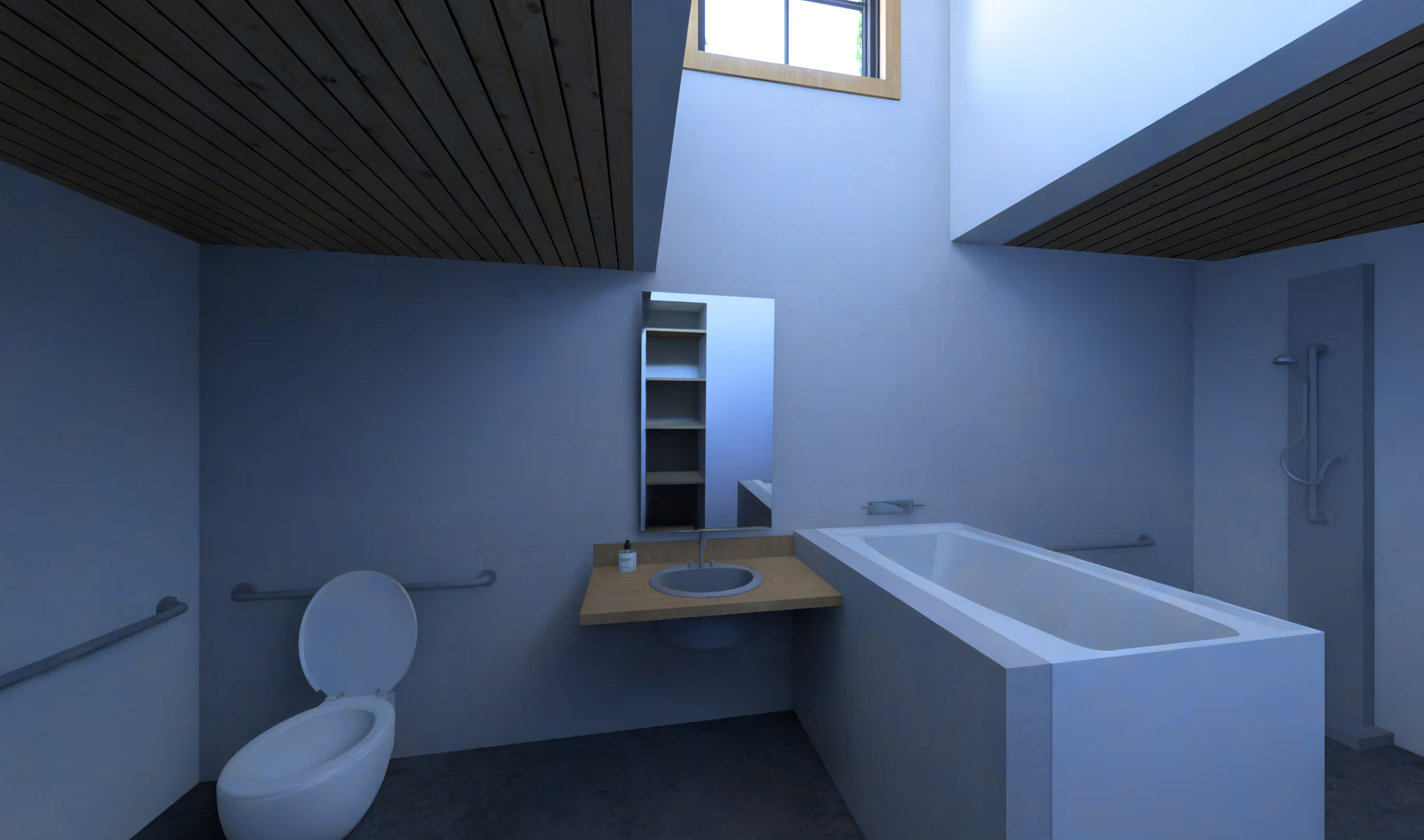
The look and feel of the bathroom will be spa-like, featuring a simple material palette, light colors, and a clean aesthetic.
The bathroom will be spacious for optimal wheelchair use and caregiver support.
Features like grab bars will be placed throughout the space (more than are required), because again, caregivers often rely on them also, and not everyone will always necessarily have access to the suspension system.
Links to:












.avif)
The house is oriented to optimize sun angles, penetrating or not, depending on time of year and day*. But the house is also designed to account for prevailing winds.
"Prevailing winds" is a term for the direction wind tends to come from, and in this climate they have tended to come from the Northwest in the Winter (when we don't generally want to be hit by cold air), and the Southwest in the Summer (when we often can benefit from some cross-ventilation and cooling).
So the house is designed with blocking the (north)westerly cold winter prevailing winds in mind, with additional layers of vegetation, insulation, walls, trees, and pockets of air**.
Likewise, the house is designed to scoop up the southwesterly winds in warmer months, so when the temperature is within certain ranges the windows can be opened, and the movement of the air can create whats called "expanded thermal comfort." This is a term for the effect of more air molecules hitting your skin and absorbing some heat from it thanks to the air moving. This increases the rate the body can release heat energy, and thus requires the air to be less cool than when it's not moving as much. Ceiling fans also offer this benefit but use up some electricity to do so (though less than air conditioning).
When early on in our design process the addition of a greenhouse was being considered, we were concerned this might jeopardize our cross ventilation because the greenhouse would block some of that southwesterly winds in some of the warmer months of the year. So we did a type of analysis called Computational Fluid Dynamics (CFD). This technology has been used for a longer period in automobile and aeronautical engineering and design so that cars and planes could be made more aerodynamic. The old fashioned way to do it is to place a model of the geometry of the object being designed in a wind tunnel (literally a room with fans at both ends to create high air speed in one direction), and then smoke being blown blowing in the fan so that the airflow is visible to the observers. CFD software allows us to assess our design in a virtual model without building a physical one yet.
Somewhat to our surprise, the introduction of the greenhouse created whats called a Venturi Effect. This is the phenomenon in which sending a fluid (usually air) through a compressed space causes it to speed up, like a nozzle on a hose, or the tapered or fluted cooling towers and smoke stacks on factories and combustion-based power plants. The breezeway between the house and the greenhouse is angled enough towards the prevailing southwesterly winds, that it captures enough wind and compresses, that that wind is actually accelerated into the house a little bit more than if the greenhouse weren't there.
Using CFD created a lot more confidence that we could not only add the additional complexity of a diverse and high tech food system to the project without sacrificing other performance goals, but in fact enhanced our achievement of those goals. The house will actually be able to use active, electricity consuming air conditioning a little bit less, because our breezeway pushes the air a little bit faster into the south-facing windows in house. As the air inside heats up a bit from contact with warm human bodies and other heat sources inside the house, this will actually help it rise a bit and then more effectively be sucked out of the high-up windows on the north wall of the house. The CFD allowed us to do a lot better than the typical ""wishful thinking arrows"" designers so often use to represent how they hope the air will flow!













Our goal of having no water leave the site horizontally unless it's in a living body (humans or other animals, or plants, usually in the form of crops). In other words any water we need to send on its way beyond those uses must leave vertically, either downward to recharge the aquifer (definition link), or upward into the sky through evaporation and evapotranspiration (definition link). This is very much how a healthy, verdant forest in this Lifeshed (definition link) works. This demands that, like a forest, we gather as much of the rainfall as we can, and use it for living system needs, often multiple times, before letting it go. This allows us to get through dry months and even full droughts, but it also means at other points we need to contribute to preventing flooding in surrounding areas but still get rid of some water, when we’ve already received plenty or even too much rain. Our huge water storage capacity will be more than sufficient most of the time, again helping with increased droughts in the future, driven by climate change. But we are also projected to get more rain in fewer rain events (i.e. big rain storms). NOAA (definition link) and other services can predict this to some extent, and we can utilize predictive information about additional forthcoming rainfall to realize we need to get rid of some water. Our first strategy will be to increase irrigation to the upper levels of our crops’ tolerances. Likewise we’ll maximize our distribution of water to local agricultural partners. Then we’ll have to get more creative.
The two main factors that reduce PV (definition link) efficiency and function are dirt (obscuring the cells from sunlight) and heat. Rinsing our solar panels would address both of these issues, and any water that didn’t evaporate into the sky, would go back through our water treatment and collection system.
Inspired initially by our goals to clean the air in the neighborhood, and realizing that air is cleanest after a big rain storm (having effective “rinsed” the atmosphere of particulate and contaminants) we had another idea. What if we misted site and its surroundings. Not only would this cool the air on the hottest days, but it would also clean it significantly. Then we realized we weren’t the first to think of this. Major cities in China, who had been suffering from the vicious cycle (definition link) of SMOG (hot conditions increase energy use for cooling, which increases energy production at power plants, many of which were actually in the cities, those plants produce more SMOG, making it hotter through the greenhouse gas effect, demanding more cooling, energy-SMOG-cooling-energy-SMOG… and so on). To attempt to short circuit this runaway set of problems they began using some of the energy to blast mist into their cities from huge water canons atop many of the buildings. While this increased energy use even further, it did contribute to SMOG reduction, and thus cooling energy use reduction, and so on. While our neighborhood’s situation is less dire and on a very different scale, the added benefit of releasing some excess water using excess renewable energy, and having all these additional benefits makes some sense, as counterintuitive (definition link) as that may me!












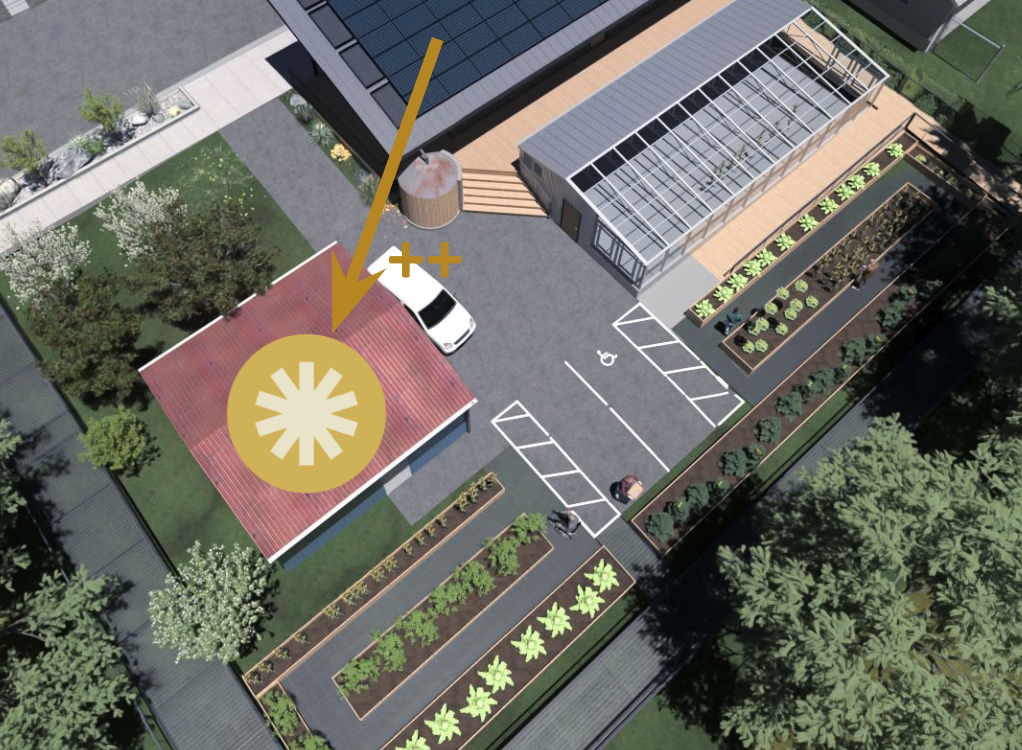
As additional technologies emerge and our ability to utilize surplus energy (for revenue and/or great resilience for neighbors) is proven and perhaps grows, utilization of the preexisting surfaces of the garage will certainly make sense. Ramboland sits at a high point in the city, and thus offers some interesting opportunities for wind generation.
Wind turbines (forthcoming link to pronunciation rant) are great in several ways. They tap into a free, ongoing, renewable “fuel” source - namely the wind generated by a multitude of interrelated factors including the rotation of the Earth, global, regional, and local topography, thermal and physical flows in water bodies, and thermal and pressure dynamics in the atmosphere. They tend to produce more energy at times solar energy systems are producing less or none (cold months and nighttime), making them an ideal addition for a more holistic approach at certain scales. Wind technology is generally limited to larger scales, because of the size of most wind turbines. They can however be disruptive to humans and other creatures alike, primarily via noise (they tend to emit a low hum or whine that is audible close to them). Noise, we have learned more recently, is one of humanity’s biggest forms of threat to other living systems, not to mention our own psychology. That said there have been some particularly interesting smaller scale technologies developed. Whether it be VAHTs (definition link) that can sit on top of building peaks or land high points, or an emerging technology we have discovered which is technically a HAWT (definition link) like the big white whirlly pinwheels we all have seen, because their axle is horizontal, but they are designed to sit directly on top of a roof ridge to take advantage of the fact that air must speed up to get over and around buildings. What little noise this newer technology creates will be fairly separated from Ron, our neighbors, and our building integrated habitat systems.
Note that wind turbines of any sort are less common in residential applications in large part because they have many moving parts (unlike solar panels), and thus have greater maintenance issues and costs. Not to mention that most of those moving parts are usually at the top of a mast, making them hard to get to in order to work on them. This all effects their lifecycle cost and feasibility, and it probably doesn't make sense for most single-family homes. Like so many things at Ramboland however, we think they might make a lot of sense for the "Goldiblocks" scale!













In most modern built-environment practice it is assumed that a human-built edifice must displace living systems – plants, insects, fungi, other animals, etc. And this is one of our self-fulfilling prophecies. Not many have taken the time to question this like Ken Yeang has. He not only challenges the idea that building must result in a total loss of biomass, but that perhaps there could be an increase in biomass, diversity, vitality, and overall living system health AFTER we have built what he calls 'ecosystem prosthetics.' After all a prosthetic is a human-made tool, instrument, or system designed to restore or expand function and/or independence. What are buildings doing if not expanding an ecosystem's ability to meet our human needs? This framing liberates creativity, but it also exposes the ways in which our buildings
aren't so great at fulfilling their own purpose. Indeed, a prosthetic that makes its user sicker, and/or kills life around its user like our buildings do, would not be considered a very good one.













Bird Houses are probably the most common form of human provided shelter or habitat for other species that aren't considered pets or "live stock." Birdhouses can be designed to accommodate somewhat specific species, to support overall ecological health and help to naturally manage insect and other animal populations – what some call "pest control." Personally, we think that term feels like putting two curse words together.
Birdhouses, also known as nest boxes, are beneficial for many reasons, including:
Nesting: Birdhouses provide a safe and private place for birds to nest and raise their young.
Wildlife habitat: Birdhouses can help qualify your outdoor area as a National Wildlife Federation Certified Wildlife Habitat.
Winter refuge: Birdhouses can provide a safe place for birds to roost and sleep during the winter, especially when protective foliage is scarce.
Pest control: Birdhouses can be used to attract swallows, which can help manage flies on farms.
Birdwatching: Birdhouses can provide a great opportunity for birdwatchers to observe the breeding process.
However, poorly designed birdhouses can be detrimental to birds. Some things to consider when placing a birdhouse include:
Location: Place the birdhouse out of the wind, rain, and strong sunlight.
Height: Place small-hole boxes 1–3 meters above the ground on tree trunks.
Materials: Use rough-cut wood slabs, tree sections, or 3/4-inch plywood. Avoid creosote-treated wood, which can kill eggs and chicks.
Paint: Paint the outside of the birdhouse with a dull color that blends in with the surroundings. Never paint the inside of the birdhouse.












.jpeg)
Vertical vegetation walls
Vertical vegetation walls offer benefits for both the environment and the buildings they essentially become a part of. They can improve air quality by acting as a natural air filter (absorbing pollutants and producing oxygen), regulate building temperatures (cool buildings by reducing the amount of solar heat absorbed by the walls, and also reduce urban heat island effects), reduce noise pollution (absorb sound, helping to reduce noise pollution in urban environments), and contribute to biodiversity (provide habitats for insects, birds, and other wildlife, help support biodiversity in urban areas). They can also help reduce stormwater runoff by absorbing and holding water.
Outdoor green roof
Green roofs can serve as habitat for numerous species, playing a role in a balanced and self-managing urban ecology. Species found in healthy, curated (initial species selection) green roofs include various insects, birds, and even some small mammals. They can act as stepping stones for migrating species, link fragmented habitats, and increase biodiversity in urban areas.
Indoor green roof
The indoor green roofs act as caps over one-story rooms or closets, allowing air to flow over them to support cross ventilation. This solution allowed us to cap those spaces in a way that minimizes cleaning and maintenance, adds additional insulation—particularly sound insulation in the case of the cap over the mechanical room—and provides added benefits such as indoor air filtration and oxygen production.












.jpeg)
Attitudes towards rain as a nuisance ("stormwater" is a pejorative term) or instead as a life-giving precious blessing (rain/water) are both self-fulfilling prophecies. We pick the second attitude. Our goal is that the hydrology of the site be nearly indistinguishable from that of the temperate forest that previously occupied this site and its surroundings. To that end rainfall is collected to be stored & used to support living processes, often several of them, before leaving the site.
Smog, bird droppings, and pollen are easily removed to create pristine water without chemical hormones, pharmaceuticals, fluoride, chlorine or Cr6), while maintaining some nutrients living bodies can benefit from. Tap water with added chlorine to kill pathogens does not make great irrigation water either, because it is a biocide.












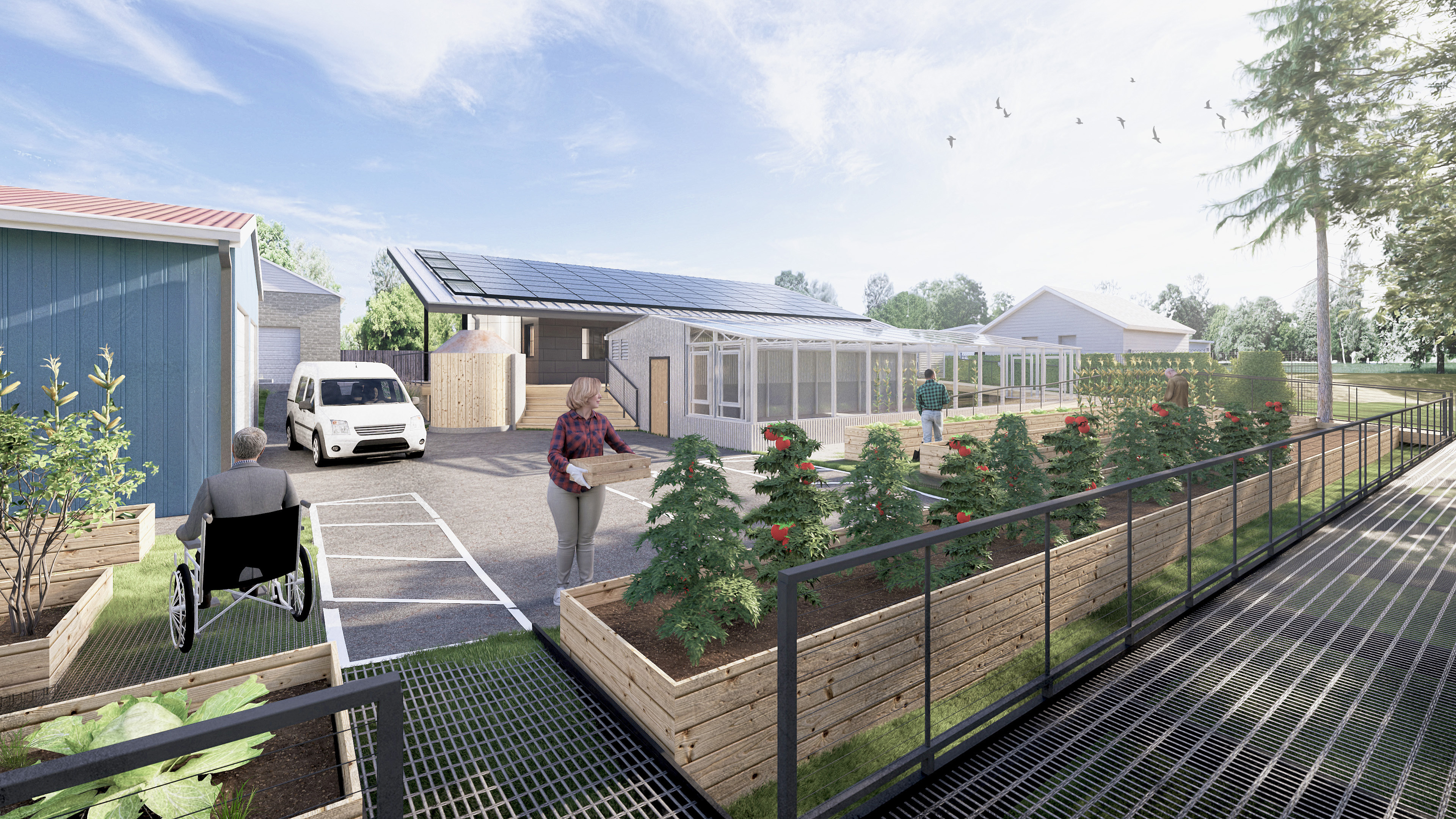
Raised gardening beds on-site are a good solution for urban farming as they allow for soil quality control, enhanced water drainage, and ease of access for people with and without mobility limitations. Raised beds will also be part of the YIMBY food system for the same reasons.












.jpeg)
It was important to Ron to have an office space, to do email and participate comfortably on Zooms. It is also important to his health and the ideal functioning of a home that accommodates a caregiver to stay overnight, at least on occasion. Given the opposite timing and some complimentary shared equipment (big TV/monitor, table surface, etc.) and our goal of maximizing feasibility and cost-effectiveness, despite doing so much more) we felt we could combine these two spaces into one. Using a large, elegantly disguised murphy bed system, we have designed a lovely, daylight, highly functional area that we believe serves both of these important uses in the same square footage. Another technique added to the list that includes the dynamic/transformer-like furniture we are including elsewhere (link to table Vignette)












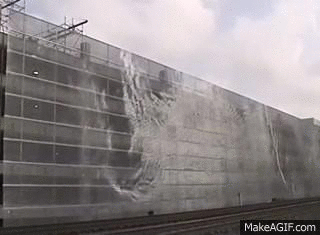
What better place to put a WIND veil than a BREEZEway?! Wind veils are beautiful, biophilic building screens that indicate the flow of air, creating liquid-like waves (which have been found to have a calming effect on humans) across the surface of the building. Not only will this be a way to create an educational element, but a way to add some beauty to a wall that was solid because of the need for energy efficiency in the greenhouse. This will help us to actually observe how accurate our CFD (computational fluid dynamics) analysis was, when we were concerned about the greenhouse inhibiting our carefully designed cross ventilation through the house.













After perfecting the geometry of a building accounting for the uses within, immediate surroundings, and larger climate considerations like sun angles, temperature, humidity, and wind all day everyday, the attributes of the building envelope are the next set of considerations in the optimization sequence:
The reflectance levels of the outside surfaces;
The window sizes, placement, insulation value (definition link), solar heat gain/rejection level (definition link), visible light transmittance (definition link), and operability (definition link), and window-wall ratio on each face of the building, all in conjunction with further tuning the building overhangs and other geometry
The walls’ and roofs’ R-value / insulation levels) and leakage rates.
Newly introduced deliberate obstructions beyond existing surrounding plants and buildings to further manage climate influences on the building.
In reality some iteration amongst all of these direct and related considerations will happen throughout design, but focusing on these at this stage is key to maximizing the health and performance of the building.












.jpeg)
Buildings don’t just sit there all closed up all the time. As people come and go we temporarily create gaping holes in the envelopes we’ve worked so hard to perfect. These gaping holes are called doors. In fact, when striving to provide greater than code levels of accessibility, these are even bigger than typical. Imagine how much repeatedly unzipping your coat on a cold day would impact your thermal comfort experience, and how much energy your body has to spend to keep warmer. Huge gulps of outdoor air are exchanged with the indoor air every time doors are operated. Unlike windows or operable wall panels, which we generally open for longer periods when the outdoor air conditions are pleasant, we open and close doors throughout the year, regardless of outdoor conditions. Not only that, as we ourselves pass in and out of the house we bring in contaminants on our wheels, shoes, clothing, and baggage… especially our wheels and shoes.
Having a vestibule (definition link) at least at the most frequently used door of a building can significantly address all of this. They’re required by code in commercial buildings for energy reasons. By limiting the “gulp of air” to a pocket between two doors and which for pressure reasons doesn’t all exchange with the outdoors, can radically reduce the threat to energy that the front door represents. They are also the perfect places for walk-off mats or grates, to get a lot of the continents off of our tread that contacts the ground outside, keeping the interior air and surfaces cleaner. Seating and rinsing systems can also make sense in such spaces, where there is room to upgrade them to being a full mudroom (definition link).